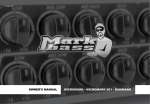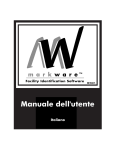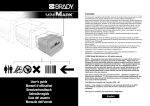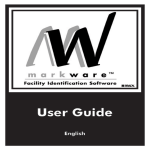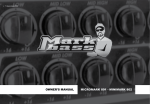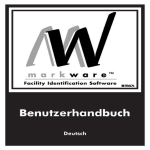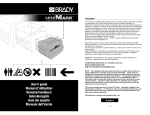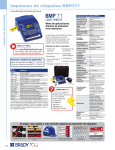Download Brady MINIMARK Instruction manual
Transcript
Copyright This manual is copyrighted with all rights reserved. No portion of this manual may be copied or reproduced by any means without the prior consent of Brady Worldwide, Inc. While every precaution has been taken in preparation of this document, Brady assumes no liability to any party for any loss or damage caused by errors or omissions or by statements resulting from negligence, accident, or any other cause. Brady further assumes no liability arising out of the application or use of any product or system described, herein; nor any liability for incidental or consequential damages arising from the use of this document. Brady disclaims all warranties of merchantability or fitness for a particular purpose. Brady reserves the right to make changes without further notice to any product or system herein to improve reliability, function, or design. Reproduction of this material, in part or whole, is strictly prohibited without the written permission of Brady Worldwide, Inc. Every effort has been made to make this guide as accurate and complete as possible. Brady Worldwide, Inc. is not responsible for labeling inaccuracies and omissions occurring during the use of this guide. This manual is proprietary to Brady Worldwide, Inc. and may be revised from time to time without notice. Brady Worldwide, Inc. disclaims any understanding to provide you with revisions, if any. All brand or product names referenced in this manual are trademarks or registered trademarks of their respective companies or organizations. MINIMARKTM and MarkWareTM are registered trademarks of Brady Worldwide, Inc. Windows is a trademark of the Microsoft Corporation. © 2005 Brady Worldwide, Inc. All rights reserved. www.bradyeurope.com (US and Canada) www.bradyid.com NOTE: This equipment has been tested and found to comply with the limits for a Class A digital device, pursuant to part 15 of the FCC Rules. These limits are designed to provide reasonable protection against harmful interference when the equipment is operated in a commercial environment. This equipment generates, uses and can radiate radio frequency energy and, if not installed and used in accordance with the instruction manual, may cause harmful interference to radio communications. Operation of this equipment in a residential area is likely to cause harmful interference in which case the user will be required to correct the interference at his own expense. This device complies with part 15 of the FCC Rules. Operation is subject to the following two conditions: (1) This device may not cause harmful interference, and (2) this device must accept any interference received, including interference that may cause undesired operation. This ISM device complies with Canadian ICES – 001 Caution: Any changes or modifications not expressly approved by the party responsible for compliance could void the user’s authority to operate the equipment. English 1 2 1. Checking Your Box Contents Receiving the box of your printer, you are advised to check first for the possible shipping damage. There are two ways you can do it: 1. Checking Your Box............................................................... 4 2. Power Supply........................................................................ 5 3. Parts and Features ............................................................... 6 4. Loading the Ribbon .............................................................. 8 5. Loading the Media .............................................................. 13 6. Operator Controls............................................................... 18 7. Performing Calibration....................................................... 19 1. Inspect the outer appearances of both the box and the printer for possible damage. 2. Raise the top cover of the printer to see if the media compartments are in order. If damages did occur, immediately file the claim to the shipping company for settlement. Having performed the primary inspections, next step, please check whether you have received the following accessories together with the printer. If there is any item missing, contact your local dealer to get it. Printer 8. Hooking up the Printer and Computer .............................. 19 9. MINIMARK Print Driver....................................................... 21 10. Troubleshooting ............................................................... 23 Parallel Cable User’s Manual 11. Caring for Your Printer..................................................... 26 12. Reference Technical Information .................................... 27 Power Adapter MARKWARE CD-ROM 3 4 2. Power Supply 3. Parts and Features WARNING: NEVER OPERATE THE PRINTER AND POWER SUPPLY IN AN AREA WHERE THEY CAN GET WET. Ready Indicator 1. The Power Adapter has a barrel connector on one end that must be inserted into the power jack on the back of the printer. Power Indicator Top Cover 2. Plug the other end of the cord into an appropriate AC electrical outlet. 3. When plugging the connector into power jack, please leave the power switch at "O" position and don' t touch the 36 pin parallel connector. AC Electrical Outlet Serial connector Power Switch Power Adapter USB connector Power Jack Barrel Connector Power Switch Cutter Feed Button Parallel connector 5 6 4. Loading the Ribbon Note: This section is not applicable to the direct thermal printing as a thermal ribbon is not required. Media Hanger 1. Lift the top cover to expose the media compartment. Release Levers Ribbon Pick-up Holder Ribbon Supply Holder Thermal Printhead 2. Unlatch the print head module by pushing the two purple release levers on the sides. 7 8 Media Compartment 4. Unwrap the ribbon roll pack and separate the ribbon roll and the bare core. 5. Attach the edge of the ribbon on the bare core and wind it a little bit onto the core. 6. Insert the ribbon roll into the supply holder. (First snap in the right side and then the left side). Release Levers Ribbon Roll Print Head Module 3. Turn over the print head module to expose the ribbon supply holder. Ribbon Supply Holder Bare Core 9 10 7. Turn back the print head module and then insert the bare core into the pick-up holder. (First snap in the right side, then the left side). Wheel Print Head Module 8. Turn the wheel of the print head module to ensure the ribbon is tightly wound. 9. Press down the print head module on both sides firmly till you hear a click on each side. 11 12 2. Remove the media hanger. 3. Load the media roll onto the hanger. 4. Unlatch the print head module. 5. Loading the Media The MINIMARK printer can be operated in two different options: Cutter On / Cutter Off. - In cutter On mode, the printer automatically cuts the label after it is printed ( 2 modes : cut between each label or cut at the end of print job). - In cutter Off mode, the printer will not cut any label. The Cutter On/Off modes are set in the Printer Setup in Markware. Media Hanger Loading the media (Continuous tape or Die-Cut labels) 1. Lift the top cover to expose the media compartment. Media Compartment Ribbon Roll 13 14 5. Lead the label through the media guides and the cutter (under the bent black plate) with the other hand. The media guide can be adjusted centrally to fit with different label width. 6. Press down the print head module firmly on both sides till you hear a click on each side. Print Head Module Media Guides 15 16 7. Close the top cover and turn on the printer or press the feed button if the printer is already on. 6. Operator Controls Power Switch Controls printer power 1. On : normal operation – "I" position 2. Off : the power should be turned off before connect or disconnect the communication cables and power cables – "O" position Feed Button Advance the label media to first printing position 1. Press to advance a small length of continuous tape or a label 2. Press to take the printer out of a "pause" condition Ready Indicator Show the printers status 1. Green : printer is ready to operate 2. Blinking : printer is paused Feed Button Power indicator Shows the power and error status 1. Off : printer power off 2. Green : printer power on 3. Blinking : error occurs Note: The feed button will not drive the printer to cut. The cutting function can be executed only when the software setting is ready. 17 18 7. Performing Calibration 1. Keep pressing the feed button while turning on the power, until the printing motor becomes activated. 2. The calibration has been performed while the printer automatically feed label for certain length. Serial (RS-232) Interface Requirements The required cable must have a nine-pin "D" type male connector on one end, which is plugged into the mating serial port located on the back of the printer. The other end of this signal interface cable connects to a serial port at the host computer. The settings for the Serial port are : Baud rate : 9600 – Stop Bit : 1 – Data Bit : 8 – Parity : None – Flow Control : Xon / Xoff 8. Hooking up the Printer and Computer Note : The power supply barrel connector must be inserted into the power jack on the back of the printer before connecting the communication cables. Power Jack This printer comes with both a nine-pin Electronics Industries Association (EIA) RS-232 serial data interface, a standard Centronics parallel interface and USB interface. In either case, you must supply the required interface cable for your application. Note : This printer complies with FCC "Rules and Regulations" , Part 15, for Class A Equipment, using fully shielded six-foot data cables. Use of longer cables or unshielded cables may increase radiated emissions above the Class A limits. 19 USB port RS-232 Serial Port Parallel Port 20 Parallel Interface Requirements The required cable (IEEE 1284-compliant is recommended) must have a standard 36-pin parallel connector on one end, which is plugged into the parallel port located on the back of the printer. The other end of the parallel interface cable connects to the parallel connector on the host computer. To minimize electrical noise pickup in the cable: Keep data cables as short as possible (6ft. [1.83m] recommended). Do not tightly bundle the data cables with power cords. Do not tie the data cables to power wire conduits. Notes : 1. Using Centronics allows for a much higher speed communication than the use of a serial. 2. It is not necessary to set the switch or send any command to select the parallel or serial port . The printer can automatically detect it. 3. A normal USB cable is used if USB port is selected. Installing MarkWare 3.4 and Higher MINIMARK Print Driver 1. Install MarkWare if not previously installed. 2. Insert the MarkWare 3.4 and higher MINIMARK CD into your CD-ROM drive. You can also download the drivers from the Brady web site at http://www.bradyeurope.com/minimark. (US and Canada) www.bradyid.com Note: If the installation CD does not AutoRun, go to Start \ Windows Explorer and then select the drive (for example, D:) where the MW3.4 and higher CD is located. 3. The Choose Setup Language box displays. Select a language and click OK. 4. The Choose Printer Port screen displays. Click the communication port you want to be used from the list and click Next. The print driver will automatically install. If USB is desired, select USB001. 5. When the print driver installation is completed, a message displays asking you to restart your computer. Choose Yes or No to restart 9. MINIMARK Print Driver The MINIMARK print driver is bundled with the Markware 3.4 and higher CD-ROM (on a separate print driver CD-ROM from Markware 3.5 and higher). This driver can be installed under Windows 98SE/NT4/2000/XP. you computer later. Set the Parameters After installing the driver, you can follow the path below to set parameters: Start 21 Settings Printers 22 MINIMARK Properties Possible Problems Solutions Label out . Supply the label roll out The parameters include: Label not installed . Install the label roll one of parallel (LPT), serial (COM), USB001 or File. Label jam . Recover the jam Paper size Select the proper size in the menu. B. Power and Ready LEDs blink alternately Ports Select the correct port to link with the printer. The port may be Orientation Set portrait or landscape according to the print direction. 10. Troubleshooting Power LED ON OFF Ready LED OFF ON Normally, when the printer is in abnormal condition, the power LED will keep blinking. The printing job and the communication between the host and printer will stop. Possible Problems Ribbon out Ribbon jam Ribbon sensor error To understand the problem, please check both LEDs first: C. Only the Power LED blinks A. Power and Ready LEDs blink at the same tempo Power LED Ready LED ON OFF ON OFF Possible Problems Solutions Miss-detect the gap . Check the label path (Die-cut label) . Check the label sensor 23 Remarks If you are using continuous label roll and run under Windows, you should select the continuous media. Power LED ON OFF Solutions Remarks . Supply the ribbon roll Not applicable to direct thermal . Recover the jam . Replace the ribbon sensor type. Ready LED ON ON Possible Problems Solutions Serial error . Check the baud rate Memory full . Add the extension RAM Cutter failed, or jam at . Check the cutter cutter . Recover the jam Hardware error Remarks . Call for service 24 Remarks Not for Centronics It occurs when cutter is activated but connection cable is disconnected 11. Caring for Your Printer D. Miscellaneous The host shows "Printer Time out" 1. Check if the communication cable( parallel, serial or USB) is connected securely to your parallel, serial or USB port on the PC and to the connector on the printer at the other end. 2. Check if the printer power is turned on. Clean the following areas of the printer after 5-8 rolls of continuous tapes or die-cut labels have been used. In each case, use a cotton bud dampened with isopropyl alcohol. Do not soak the cotton bud excessively. If the power cord is connected, the power switch is at position "I" and the power LED has still not illuminated, check the fuse inside the power adapter case. Cleaning The data has been sent, but there is no output from the printer. Check the active printer driver, if MINIMARK printer has been selected. Vertical streaks in the printout usually indicate a dirty or faulty print head. Clean the print head first, if they still persist, replace the print head. Poor printout quality. . The ribbon may not be qualified. . The media may not be qualified. . Adjust the Darkness ( heat temperature ). . Slow down the print speed. . Refer to the next chapter and clean the related spare parts. Thermal Print Head Thermal paper and ribbon will release debris on the print head and degrade printing quality. Clean the print head with isopropyl alcohol with a cotton bud. Do not touch the heater element with your fingers. Debris or dirt on the roller should be cleaned with alcohol. Paper Sensor Debris or dirt on the paper sensor will cause a miss-read or unstable detection of the label gap. Clean with a cotton bud dampened with alcohol. Note : Always switch off the power before cleaning. Recovery To continue your print jobs after the abnormal conditions have been corrected, simply press the panel button or restart the printer. Make sure that the LED is not blinking and remember to resend your files. 25 26 12. Reference Technical Information MINIMARK Specifications Printing method Printing resolution Printing speed Printing length Printing width Thermal Transfer 203 dpi (8dots/mm) 1 ~ 4 ips (51~ 102 mm/s) 4" is automatically reduced to 3" if cutter On 1” ~ 45” (25mm ~ 1143mm) Max 4.1” (104 mm) 2 MB DRAM 2 MB Flash ROM 32 bit RISC microprocessor Reflective See - through LED indicators x 2 Memory CPU type Media sensor Display Operation interface Communication interface Software Media Ribbon Power source Agency listing Operation environment Cutter Button x 1 Centronics RS-232 serial Bi-USB (Full Speed) MARKWARE, version 3.4 and higher Continuous tapes die-cut labels; Thermal paper or Vinyl / Polyester Max width 4.25” (108 mm) Min width 1.0” (25.4 mm) Thickness .0025”~. 01” (.0635mm ~. 254mm) Wax, Wax/Resin, Resin (Outside coating ribbon) Ribbon width –4” Ribbon length – max 100 M 110/220 VAC ± 10%, 50/60 Hz, external power adapter CE, UL, CUL, FCC class A, CCC 40ºF ~ 100ºF (4ºC~38ºC) ; 10~90% non condensing Rotary Cutter 27














